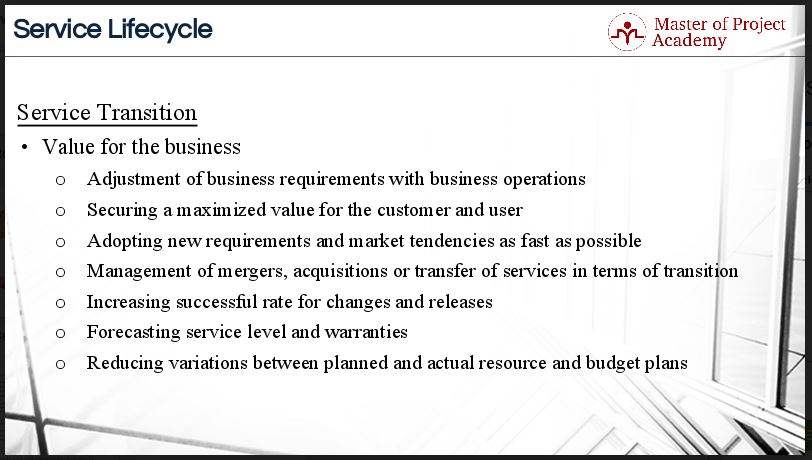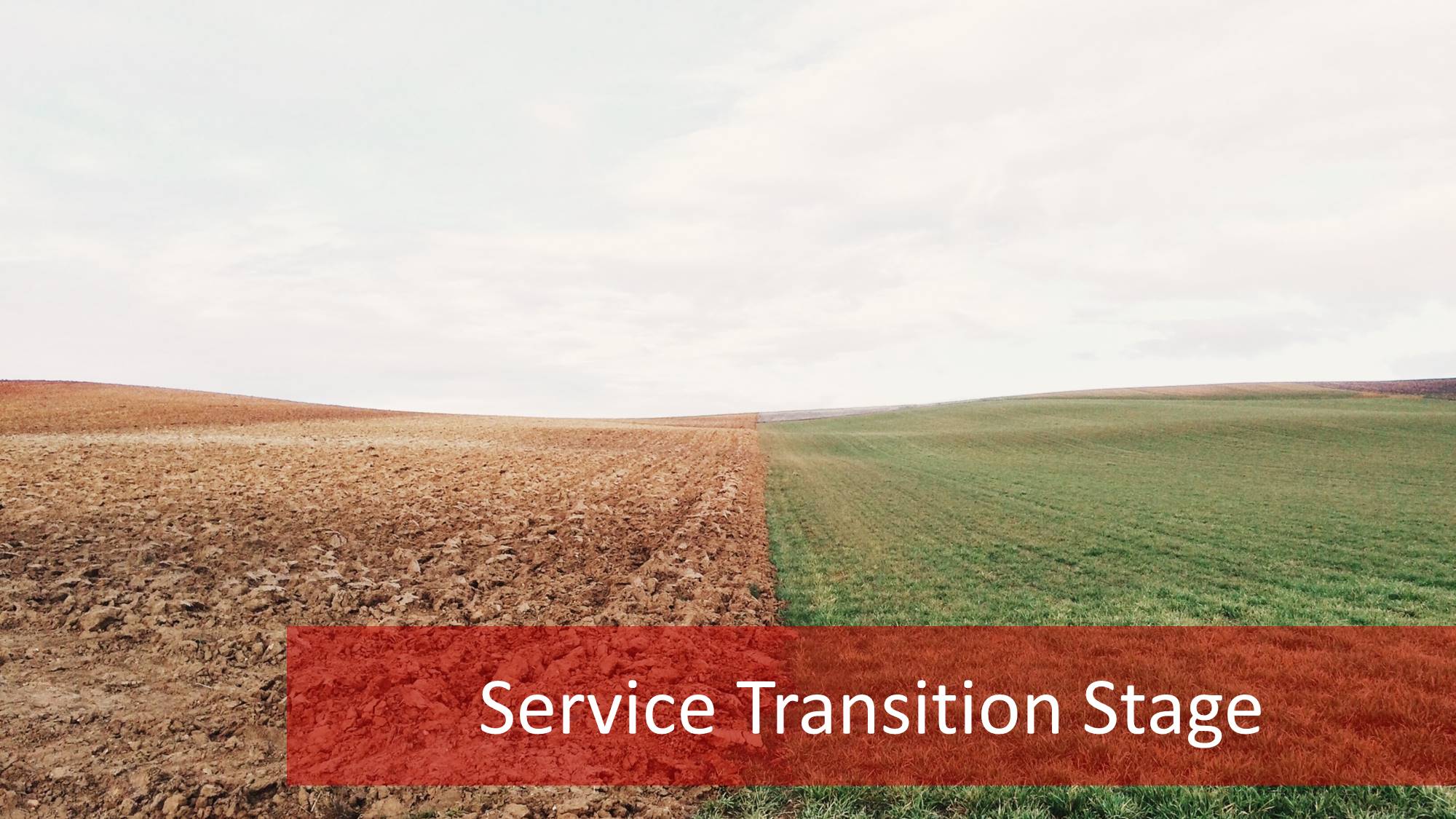Do you know what is the role of ITIL Service Transition? The ITIL Service Transition stage is the third stage in the ITIL Service Lifecycle as discussed in the ITIL Foundation Overview course. According to the lifecycle model, the service lifecycle starts with the Service Strategy stage in which the IT strategy is aligned with the business strategic objectives. The second stage is the Service Design stage during which guidelines are developed for the development of the service or service upgrade. The ITIL Service Transition stage is the third stage of this model and the topic of this article and is also discussed in depth in the ITIL Foundation Certification Training course.In this article we are going to discuss the role of ITIL Service Transition.
The Scope of the ITIL Service Transition Stage
First, it is necessary to understand the scope of the preceding Service Design phase. Service Design stage scope covers guidance for the transformation of a new or changed service into operations. Based on the business vision and requirements of an organization, an IT strategy is developed. And in order to ensure the execution of the developed strategy, new services or existing services are shaped during Service Design stage. In the ITIL Service Transition stage that follows, newly designed services or restructured existing services are transferred to operations. The main scope of Service Transition stage is ensuring the successful transition of new or changed services into operations.
Practices of the ITIL Service Transition Stage
Before giving the details of the role of ITIL Service Transition, let’s see the practices. The ITIL Service Transition stage includes the following practices:
Release management in the ITIL Service Transition stage
Release management ensures consistent delivery of interrelated services and successful integration of overall service operation. It covers which services need to be transferred when, their interdependencies with each other, and comprehensive operation of all services. For instance, let’s say that you upgraded your customer login screen of your web page in your organization. If your new screen also requires an updated version of customer query services during login, all these dependencies and successfully delivery of all related services are ensured with release management.
Program management in the ITIL Service Transition stage
Program management ensures successful delivery of interrelated projects. Let’s say that you are upgrading the database of a telecom operator. There might be several projects to ensure the successful upgrade of the database. For instance, design and creation of a new database is a project and migration of data from existing database to new database is another project. And in order to migrate your data from an existing database, you need to complete the new database creation project first. These kinds of interdependencies between projects are done under program management and within the scope of ITIL Service Transition.
Risk management in the ITIL Service Transition stage
When introducing new services or updating existing services, several risks might occur. These risks should be listed and proper preventive actions should be taken in order to eliminate risks. If preventive actions are not possible, risk response plans and actions should be prepared in order to overcome impacts of risks when they have occurred.
The Purpose
ITIL Service Transition facilitates planning and management of resources
The first purpose is the planning and management of resources and capacities needed for package, build, test and deployment. In order to transfer new or changed services into operations, you will need tools, software, people etc. Therefore, in order to ensure a successful transition of new or changed services, resource and capacity management should be done.
ITIL Service Transition provides a framework for evaluation of service capability and risk profiles
The second purpose is providing a framework for the evaluation of service capability and risk profiles before the release or deployment. In order to see possible impacts and assess the efficiency of new and changed services before transferring into operations, a proper framework should be implemented. In this way, new or changed services should be developed, tested and verified before transferring into operations. This will reduce the impact of risks or failures in operations.
ITIL Service Transition ensures integrity of service assets and configurations
The third purpose is building up and adherence to the integrity to all identified service assets and configurations. There might be several services in an organization and all these services will be in relation to each other. For instance, a money withdrawal service can use customer inquiry service from a database. If you make a change in money withdrawal service, and if you cannot assess the impact of this change properly, the new change might not be working properly in the customer inquiry service. And this can cause money withdrawals to stop in operations stage which will cause customer dissatisfaction. The ITIL Service Transition stage ensures a comprehensive successful transition of interrelated services into operations.
ITIL Service Transition provides efficient and repeatable build and transition mechanisms
The fourth and last purpose is the provision of an efficient and repeatable build and installation mechanism. In order to compete with rivals in the market, an organization should improve its services progressively. Since new services or changed services will be put into operations regularly, an efficient and repeatable build and deployment mechanism must be provisioned.
The Goals
ITIL Service Transition Controls Customer Expectations
The ITIL Service transition stage aims to control customer expectations concerning the enabling of business changes. Due to new or changed services, the working of the business might be changing as well. And these changes should be controlled by the help of ITIL Service Transition stage. For instance, if you are introducing a fingerprint recognition feature in ATMs of your bank, this will change the business of customer recognition as well. And these changes in businesses should be managed during ITIL Service Transition stage. For instance, tests and verifications done during ITIL Service Transition will enable the business to see customer reactions before transferring these new or changed services into operations.
ITIL Service Transition aims to reduce variance in performance
ITIL Service Transition stage also aims to reduce variations between the predicted and actual performance of transitioned services. During tests and verifications in ITIL Service Transition stage, the performance of a service is assessed before going into operations. If a service is not meeting the expected level of performance, corrections or improvements can be done before transferring into operations.
ITIL Service Transition ensures a usable service
ITIL Service Transition also ensures that a service can be used. Although a new service is designed or a service is changed properly, there might be problems when working in conjunction with other interrelated services. The ITIL Service Transition stage verifies that new or changed services can be used without any problem in operations.
The objectives of the ITIL Service Transition Stage
ITIL Service Transition facilitates planning and management of resources
Building packages, testing, integration, and deployment of new or changed services are done during Service Transition stage. And for all these, resources and capabilities should be managed properly.
ITIL Service Transition reduces impact on services
Service Transition stage also reduces any unexpected impact on services. By testing, verifying and checking interrelations of services during service transition stage, any negative impact of improper implication will be seen before putting services into operations. Corrections or improvements will be able to be planned and done.
ITIL Service Transition facilitates customer, user and staff satisfaction
Since service transition enables tested, verified and consistent services to be transferred to the operations, customer, user, and staff satisfaction will be increased.

ITIL Service Transition improves use of services
The Service Transition stage of the ITIL Service Lifecycle also targets to improve the considered use of services.
ITIL Service Transition aligns IT plans with business plans
A business plan might include delivery of different features or projects in different times. For instance, a new website of a bank can be planned for the end of the year. A new ATM development of a bank can be planned before the end of August etc. These business plans are delivered with the help of ITIL Service Transition stage. If there are interrelated or predecessor, successor relationships with other services or projects in the organization, the planning of the proper order of transition of services or projects are ensured in service transition stage.
ITIL Service Transition Value to the Business
ITIL Service Transition adjusts business requirements with business operation
The ITIL Service Transition stage adjusts business requirements with business operations. Business
vision, strategy, and requirements of an organization are planned, developed, tested, verified and delivered into operations during ITIL Service Transition stage.
It secures maximum value for customers and users
Maximized value for customers and users are secured. By testing, verifying, and risk planning, impacts of services that might cause customer dissatisfaction are minimized. With the help of the necessary tools, software, and resources, new requirements and market tendencies are aimed to be adopted as fast as possible. In order to adopt new technologies or service improvements, a suitable framework should be designed by the organization.
It facilitates the management of mergers, spin-offs, and acquisitions
Companies might take strategic decisions such as mergers, spin-offs, or acquisitions. These might require existing services to be updated or new services to be developed and transferred to operations. During mergers, spin-offs or acquisitions, transition management of services are done during the ITIL Service Transition stage.
It increases success rate for changes and releases
Because ITIL service transition stage works in accordance with a framework and this framework enables consistent and successful delivery of interrelated services.

It helps to forecast service levels
Since tests and verifications of new or changed services are done during the ITIL Service Transition stage, this stage also helps to forecast service levels and warranties about new services or changed services.
It reduces variation
The ITIL Service Transition stage reduces the variation between planned and actual resources and budget plans. Let’s say that your company is planning to implement a new service that will enable customer representatives to handle a customer operation in 10 seconds. During the service transition stage, with the help of testing and verification steps, you will be able to see whether you will be able to meet your targeted levels. If you cannot meet required and planned levels with existing resources or budgets, you should reevaluate how to meet targeted levels of service. Therefore, the Service Transition stage helps you to assess your status and reduce the variation between planned and actual values.
Now you know what is the role of ITIL Service Transition!

24 thoughts on “ITIL Service Transition: What is the Role of ITIL Service Transition in the ITIL Service Lifecycle?”
Comments are closed.